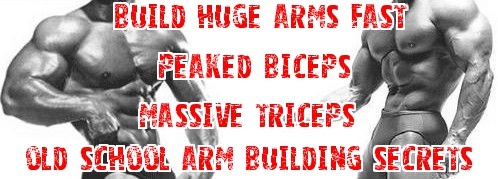Click Here For Your FREE Big Arm Workouts Magazine
Arm Hypertrophy Program
Build Big Arms Workouts
Download Now!
Bicep and Tricep Hypertrophy

Wikipedia defines hypertrophy as "the increase in the volume of an organ or tissue due to the enlargement of its component cells". For decades hypertrophy was considered to be what is known as hyperplasia which is the duplication of muscle cells but this has now been proven as incorrect.
Basically the only way to achieve any hypertrophy in any muscle group is with progressive resistance, which is achieved through lifting progressively heavier weights so that your muscles adapt by getting larger. This is very different to the duplication of muscle cells, which is hyperplasia.
The arms are made up of three basic groups of muscles, which are Biceps Brachii (Bis), Brachialis and the Triceps Brachii (Tris). When your objective is to increase the size of your arms then the only proven way to achieve that is by lifting heavier and heavier weights using a regular training program.
The biceps have two basic functions and the one is the flexion, which occurs at the elbow as well as supination of the proximal radial-ulnar joint. It is important to realize that the function of supination of the biceps is necessary due to the radial tuberosity, which is on the ulnar side of the radius.
It is because of the vitally important function of the biceps that one should always make sure that you are supinating when you train your biceps with dumbbells. The same can be said for the triceps although the three heads of the triceps are not able to supinate like the biceps can.
The triceps brachii has three heads consisting of a long, lateral, and medial head. The lateral head which, originates from the infraglenoid tubercle is part of the scapula. Whereas the lateral head will originate from the posteriolateral humerus as opposed to the medial head, which originates from the distal posteromedial humerus.
The main function of the triceps brachii is the extension of the elbow or any pushing motion away from your body like a bench-press. The last muscle group in the arm is the brachialis, which is a muscle on the forearm and inserts in the humerous.
Often the brachialis is not seen as a well-developed muscle unless it is specifically trained. The brachialis inserts deep in the biceps brachii and originates at the distal anterior humerous but inserts on the ulnar tuberosity. Although the brachialis does not participate in any supination or pronation of the radial-ulnar joint it is still involved in the flexion of the ulna towards the humerous when supination is done.
This is important as mentioned above you should always do dumbbell work when training your biceps so that you can do some supination and get top use the maximal amount of muscle fibers when training your arms. Although the sets and reps that you train when working your arms is important it is also very important to concentrate on the form or technique that you are using to achieve maximum tension.
If you have been training for more than a year and you feel that the amount of muscle you have put on is not balanced with your arms then there is a way that you can increase your strength and put on some more muscle. Although still a very controversial subject it is highly recommended that you train with low reps when doing arms.
Below you will see a typical arm strengthening routine, which should be done no more than twice a week. You need to always keep a constant lookout for any signs of over-training which is something that can happen as the arms are training four times a week if you think of training your back and your chest as well.
1. Barbell Curl 5 X 4-6
2. Close Grip Bench Press 5 X 4-6
3. Cable Barbell Curl 4 X 8-12 (followed by partials)
4. Lying Triceps extension (skull-crushers) 4 X 8
5. Cable Triceps Pressdown 4 X 8-12 (followed by partials)For more information go to Old School Arm Training
Click Here For Your FREE Big Arm Workouts Magazine

